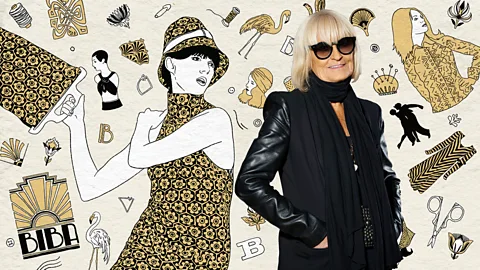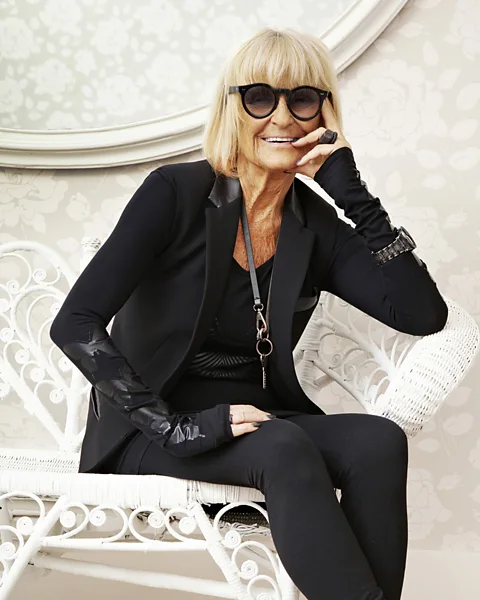'Biba attracted troublemakers': Barbara Hulanicki on breaking rules and revolutionising fashion
 Emmanuel Lafont
Emmanuel LafontIn the 1960s, Barbara Hulanicki disrupted the stuffy, class-ridden view of fashion, and the inclusive Biba lifestyle changed everything. She talks to the BBC about her extraordinary career.
"Biba attracted troublemakers or people who liked to make trouble," asserts Barbara Hulanicki, the ever-energetic founder of the legendary British 1960s and 70s label and four boutiques, now aged 87. Her cutting-edge retail ventures culminated in its largest, final incarnation, the seven-storey Big Biba, which occupied the former Art Deco Derry & Toms department store on London's Kensington Hight Street. The latter offered fashion, homeware, a food hall, beauty salon, 500-seat restaurant in the top-floor Rainbow Room, and roof terrace with a garden, flamingos and errant penguins (some were once found waddling down into the store). Big Biba was the highpoint of a trailblazing career that saw Hulanicki disrupt a class-ridden, stuffy view of fashion, and usher in a more fun-loving, youthful, affordable and egalitarian approach to dressing.
 Tessa Hallmann
Tessa HallmannBiba's aesthetic might seem retrograde – especially in the forward-looking 1960s context of futuristic, space-age fashion and design. But Hulanicki counterintuitively grasped the nascent appeal of Edwardiana and Victoriana and, later, Art Deco, all poised to enjoy huge revivals. Biba's early shop interiors – the original one occupied an old chemist on Abingdon Road, Kensington and opened in 1964 – channelled fin-de-siècle exoticism.
Hulanicki worked closely with creative people who shared her mindset. Designer Julie Hodges designed Orientalist wallpaper with large-scale motifs in opulent shades like rose madder gold. The shops were furnished with bentwood coat stands and chairs whose curlicues echoed the sinuous lines of the sumptuous black-on-old-gold graphics and logos dreamt up for Biba by Antony Little (co-founder of Osborne and Little) in the mid-1960s. "Bordello" and "souk" were descriptions Hulanicki and others bandied about to describe the boutiques' interiors, where customers not only scrambled to buy the latest, low-priced garments but were also invited to lounge on their window seats or floor-level velvet cushions.
 Barbara Hulanicki Archive
Barbara Hulanicki ArchiveOn the fashion front, publicity shots pictured winsome models, faces framed by bubble curls and turbans, throats adorned by chokers; Hulanicki's gouache or watercolour fashion illustrations for Biba pictured willowy, sooty-eyed women with frizzy hairdos reminiscent of Gustav KIimt paintings of bohemian beauties. By 1970, 1930s old Hollywood began to be its principle inspiration. Nineteen-twenties-style cloche hats and feather boas had long hung casually from the boutiques' coat stands but, increasingly, elaborate publicity photographs showed models, notably Twiggy, languorously reclining in liquescent satin, ankle-length, bias-cut dresses paired with towering 1930s-style platforms. The latter look was vampish – a Biba leitmotif was leopard print stamped on clothes and homeware.
Yet Biba was forward-looking socially: it effortlessly espoused and promoted progressive values and a permissive spirit that helped accelerate the snowballing radical social changes of the day, such as feminism, gay liberation and black civil rights. When, in 1971 the far-left anti-capitalist terrorist group, The Angry Brigade, detonated a bomb in the third Biba boutique – on Kensington High Street – in protest against women's enslavement to fashion, they were missing the point. Biba's ethos was playful, offering customers a pluralist dressing-up box of looks that consciously interwove high style (on a budget) with kitsch, while not idolising consumerism. For Hulanicki, who co-founded Biba with her husband Stephen Fitz-Simon, who ran the business side, offering an enjoyable haven for rebels was more important than turning a tidy profit.
 Barbara Hulanicki Archive
Barbara Hulanicki Archive"There was so much money going through the tills – every hour, someone would take the money out and give it to Fitz," recalls Hulanicki, who was born in Warsaw to Polish parents. "One day, a shop assistant accidentally gave a customer a bag of money instead of the carrier bag of clothes she had bought." Shoplifting was rife but was seen as a useful indication of the success (or failure) of a new garment or collection: "Everyone was welcome to be part of our community. I'd think: 'Help yourselves! If you like it, steal! When new stock came in, I'd ask the shop girls: 'How is it selling">window._taboola = window._taboola || []; _taboola.push({ mode: 'alternating-thumbnails-a', container: 'taboola-below-article', placement: 'Below Article', target_type: 'mix' });
